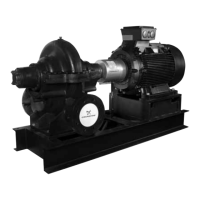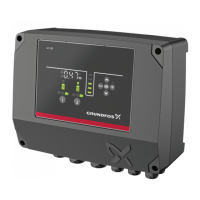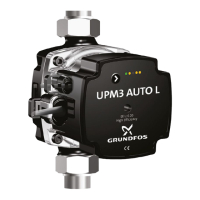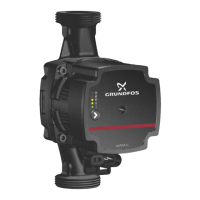3.3.1 Frequency converter operation
You can connect all three-phase motors to a
frequency converter.
However, frequency converter operation often
exposes the motor insulation system to a heavier load
and causes the motor to be more noisy than usual
due to eddy currents caused by voltage peaks.
If in doubt whether the supplied motor can
handle frequency converter operation,
contact the motor supplier.
In addition, large motors driven via a frequency
converter will be loaded by bearing currents.
When the pump is operated via a frequency
converter, check the following operating conditions:
Operating con-
ditions
Action
2-, 4- and 6-pole
motors, frame
size 225 and
larger
Ensure that the non-drive-end
motor bearing is electrically isola-
ted.
Noise-critical ap-
plications
Fit a dU/dt filter between the mo-
tor and the frequency converter.
It reduces the voltage peaks and
thus the noise.
Particularly
noise-critical ap-
plications
Fit a sinusoidal filter.
Cable length
Fit a cable that meets the specifi-
cations laid down by the frequen-
cy converter supplier. The length
of the cable between the motor
and frequency converter affects
the motor load.
Supply voltage
up to 500 V
Make sure that the motor is suit-
able for frequency converter op-
eration.
Supply voltage
between 500 V
and 690 V
• Fit a dU/dt filter. It reduces
the voltage peaks and thus
the noise.
• Or make sure that the motor
has reinforced insulation.
Supply voltage of
690 V and up-
wards
• Fit a dU/dt filter.
• Make sure that the motor has
reinforced insulation.
3.4 Pipes
Protective covers are fitted to the inlet and
outlet ports to prevent foreign bodies from
entering the pump during transportation
and installation. Remove these covers
from the pump before connecting any
pipes.
Inlet and outlet pipe
In order to minimise friction losses and hydraulic
noise in the pipes, choose a pipe that is one or two
sizes larger than the pump inlet and outlet ports.
Typically, flow velocities must not exceed 2 m/s (6 ft/
sec) for the inlet pipe (port) and 3 m/s (9 ft/sec) for
the outlet pipe (port).
Make sure that the NPSH available (NPSHA) is
higher than the NPSH required (NPSHR). NPSH =
Net Positive Suction Head.
3.4.1 General precautions
When installing the pipes, observe these precautions:
1. Always run the pipes directly to the pump.
2. Do not move the pump to the pipes. This could
make the final alignment impossible and cause
stress to the pump flanges and pipes.
Make sure that both the inlet and outlet
pipes are independently supported
near the pump so that no strain is
transmitted to the pump when you
tighten the flange bolts. Use pipe hang-
ers or other supports with necessary
spacing to provide support.
3. When you use expansion joints in the pipe
system, fit the joints at a minimum distance of 2
pipe diameters away from the pump on the inlet
side. This prevents turbulence in the joints, thus
ensuring optimum inlet conditions.
4. Install the pipes as straight as possible and avoid
unnecessary bends. Where necessary, use 45 °
or long-sweep 90 ° fittings to reduce friction loss.
5. Make sure that all pipe joints are tight.
6. Where you use flanged joints, ensure that the
inside diameters match properly.
7. Remove burrs and sharp edges when making up
joints.
8. Make sure that the pipes do not cause stress or
strain in the pump.
9. Provide for expansion of pipe material by means
of expansion joints on both sides of the pump.
10. Always allow sufficient space and accessibility for
maintenance and inspection.
11
English (GB)

